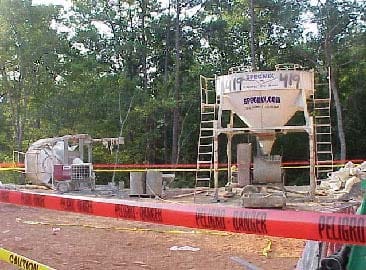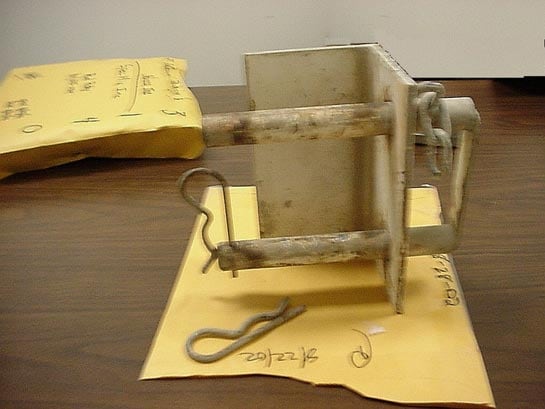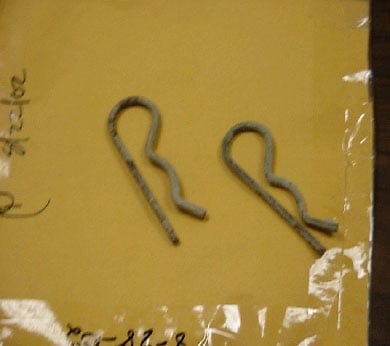Hispanic Construction Laborer Dies After Portable Silo Collapse - North Carolina
NIOSH In-house FACE Report 2002-11
February 12, 2003
Summary
A 45-year-old male Hispanic construction laborer (the victim) died after a retractable leg on a portable silo collapsed, causing the silo to fall over and crush him. The silo contained aggregates to mix stucco, which other crew members were applying to chimneys on the roof of newly constructed condominium units. The victim was operating the silo, dumping the aggregates through the silo’s chute into a cement mixer to prepare the stucco that was to be applied. A coworker used a forklift to raise the silo off the victim and other workers pulled the victim clear. The victim had a faint pulse. The emergency medical services responded and transported the victim to the hospital where he was pronounced dead.
NIOSH investigators concluded that, to help prevent similar incidents, employers should:
- ensure that equipment is set up according to manufacturers’ recommendations and specifications
- inspect equipment on a daily basis before the start of work and immediately repair any damaged components
- develop, implement, and enforce a comprehensive written safety program for all workers which includes training in the recognition of hazards that might be encountered during the performance of their duties and the avoidance of unsafe conditions

|
|
This photo illustrates the collapsed silo on the left, the remaining standing silo on the right, and the scrap lumber used for foot pads for the silo legs.
|
Introduction
On August 22, 2002, a 45-year-old male Hispanic construction laborer (the victim) died after a retractable leg on a portable silo collapsed, causing the silo to fall over and crush him. On August 29, 2002, the National Institute for Occupational Safety and Health (NIOSH), Division of Safety Research (DSR), was notified of the incident by officials of the North Carolina Occupational Safety and Health Administration (NCOSHA). On September 17-20, 2002, a DSR safety and health manager conducted an investigation of the incident. The incident was discussed with employer representatives, the site superintendent, representatives of the silo manufacturer, an accident reconstructionist for the silo manufacturer, the lead police detective, and the NCOSHA compliance officer assigned to the case. Police and NCOSHA photographs taken immediately following the incident were reviewed and the silo, double leg pin and cotter pins were photographed.
The employer was a masonry contractor that employed 20 Hispanic workers, 9 of whom were at the incident site. None of the workers at the site could speak or understand English. The company owner could speak broken English. An Hispanic NCOSHA compliance officer translated witness statements into English. It could not be determined how long the company had been in operation. There was no evidence that the company had any type of safety and health program. The company owner said he had instructed his employees in the use of fall protection; however, this training was not documented. When the portable silo was delivered to the site, a manufacturer representative conducted training in the operation of the silo. The company owner translated the training for the workers, who were then issued operation manuals for the silo that were written in Spanish and English. The training covered the proper transport, setup, and operation of the portable silo. This training was conducted several weeks before the victim was hired by the employer. The victim, who had worked for the employer for 2 weeks, had received no training. This was the employer’s first fatality. The literacy level of the workers could not be determined.
Back to Top
Investigation
The employer had been subcontracted by a subcontractor to apply stucco to the chimneys on 13 new three-story condominium units. To assist in the mixing of the aggregates, the employer had rented two portable silos and mechanical mixers. The mixers had been delivered to the site and set up several weeks before the incident.
The silos were equipped with four telescoping legs. The silos were lifted from the delivery flatbeds using a forklift. Two fork tubes, 26 inches apart, were located at the bottom of the silo. The forklift forks were inserted into the tubes and the silos were lifted and transported to the desired location. The process of setting up the silos consisted of lifting them slightly and pulling two-pronged hitch pins (Photo 1) from the legs and receiver tubes. The silos were then raised higher until the telescopic legs were at full adjustment. The hitch pins were then reinserted through the receiver tubes and silo legs, securing them from collapse. The silos were then lowered to the ground onto pieces of scrap lumber of various lengths and widths which were used as pads for the legs. Since the silos were delivered, they had been moved and set up with the legs extended two additional times.

|
|
Photo 1. This photo illustrates the two-pronged hitch pin used to hold the silo legs in place.
|
On the day of the incident, the silos were positioned between condominium units 12 and 13. The victim was operating the silo dispensing aggregates into the mixer and preparing the stucco. A coworker was using a forklift to raise the mixture to the roof of unit 12, and two coworkers were applying the mixture to the chimneys on unit 12.
As the coworkers on the forklift and roof were performing their duties, they heard a loud crash. As they looked in the direction of the silos, all they could see was a large cloud of dust caused by the aggregates when the silo collapsed. As the dust cleared, they saw that the victim was pinned underneath the silo. The coworkers came down from the roof, and they and the forklift operator went to assist the victim. They decided to use the forklift to lift the silo and free the victim. As the silo was lifted, the two coworkers pulled the victim clear. As the victim was being pulled free, the superintendent for the general contractor arrived at the scene and called 911. He then went to the victim and found the victim not breathing but had a faint pulse. He initiated cardiopulmonary resuscitation (CPR) while the forklift operator went to unit 2 to get the victim’s employer. EMS personnel transported the victim to the hospital where he was pronounced dead.
Investigation at the scene revealed that scrap lumber was used as foot pads for the silo legs. Examination of the hitch pin from the collapsed leg showed that the cotter key holding it in place was sprung and would fall out if turned upside down or if vibration occurred (Photo 2). The lead police detective said that when he arrived at the scene, the hitch pin was lying on the ground next to the collapsed leg.

|
|
Photo 2. This photo illustrates the sprung cotter key on the left and a properly functioning cotter key on the right.
|
Evidence suggests that the scrap lumber leg pads may have shifted, causing the silo to start to roll to the side. As the pressure was relieved on the leg that collapsed, the hitch pin fell from the telescopic leg and receiver tube. This allowed the leg to fully collapse and the silo to fall to the ground.
Back to Top
Cause of Death
The death certificate listed the cause of death as crushing injuries to the chest.
Recommendations and Discussion
Recommendation #1: Employers should ensure that equipment is set up according to manufacturers’ recommendations and specifications.
Discussion: The silo manufacturer’s safety manual recommended that the silo legs be placed on either 8-inch-wide by 12-foot-long by 4-inch-thick concrete footers with a minimum compressive strength of 3,500 pounds per square inch or three ¾-inch-thick, 2-foot-square pieces of treated laminated plywood held together by screws. This would ensure the stability of the silo. The scrap lumber used as foot pads for the legs was not secured in any way and may have shifted, causing the silo to begin to roll to the side.
Recommendation #2: Employers should inspect equipment on a daily basis before the start of work and immediately repair any damaged components.
Discussion: The sprung cotter key holding the hitch pin in the silo leg fell out of the hitch pin leg either before or as the silo began to roll sideways, allowing the silo leg to collapse and the silo to fall. Discussions with the manufacturer representative led to the conclusion that it was highly unlikely that the hitch pin vibrated free from the silo leg during normal operation because of the silo weight (approximately 2 tons when empty). Inspection of the equipment before the start of or during work may have identified the sprung cotter key. Had the cotter key been replaced, it may have prevented the total collapse of the silo.
Recommendation #3: Employers should develop, implement, and enforce a comprehensive written safety program for all workers which includes training in the recognition of hazards that might be encountered during the performance of their duties and the avoidance of unsafe conditions.
Discussion: A comprehensive safety program should be developed that includes training in hazard recognition and the avoidance of unsafe conditions. Employers should not allow workers to perform any work until appropriate safety training has been provided for the tasks assigned. In this incident, the victim had not been provided with safety training.
OSHA regulations require employers to train workers to recognize and avoid unsafe conditions that may be present in their work environment and to provide training on the regulations applicable to their work (e.g., 29 CFR 1926).1 Employers are to assure that each employee has been trained, as necessary, by a “competent person.” If a potential language barrier exists, the employees should receive the training in their primary language. Any training materials used should match the literacy level of the employees being trained.
Back to Top
Reference
- Code of Federal Regulations 2000 edition. 29CFR Part 1926. U.S. Government Printing Office, Office of the Federal Register, Washington, D.C.
Investigator Information
This investigation was conducted by Virgil J. Casini, Lead, Safety and Occupational Health Manager, Fatality Assessment and Control Evaluation Team, Surveillance and Field Investigations Branch, Division of Safety Research.
